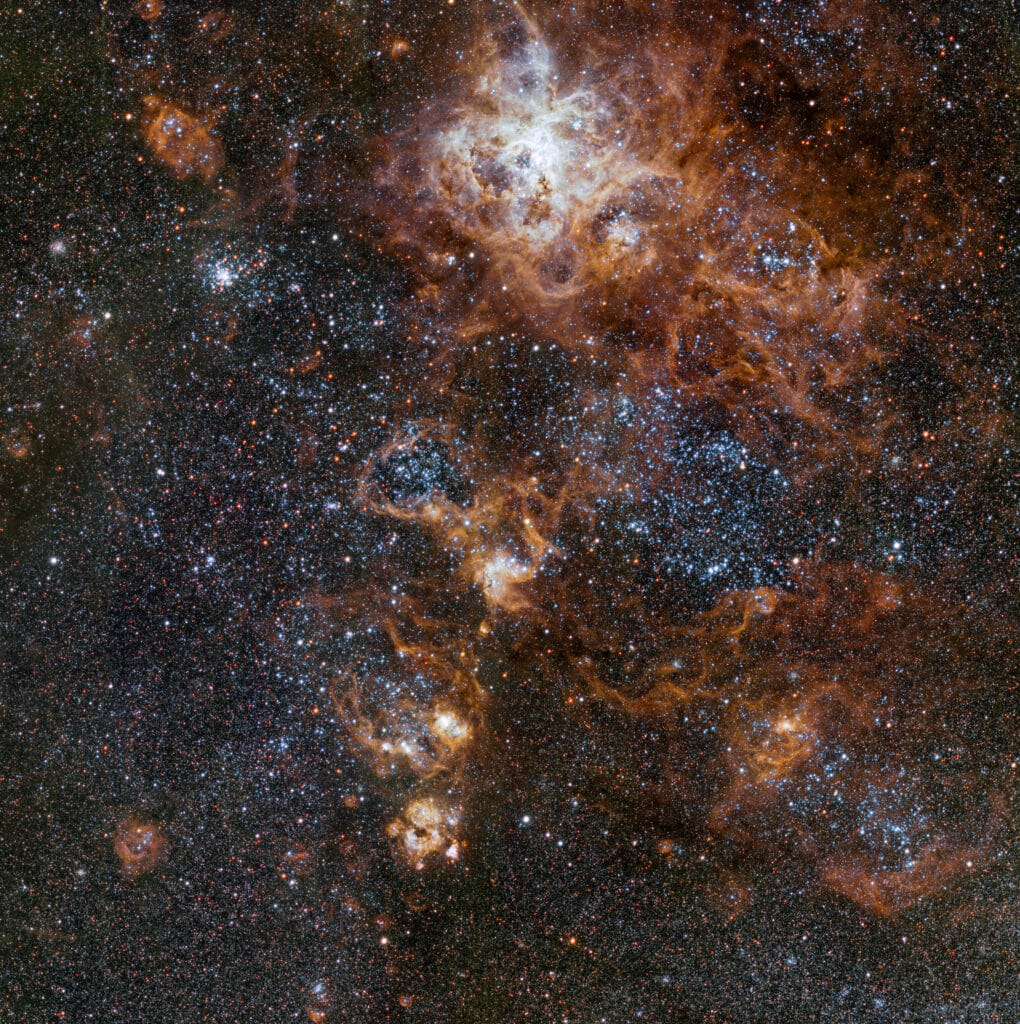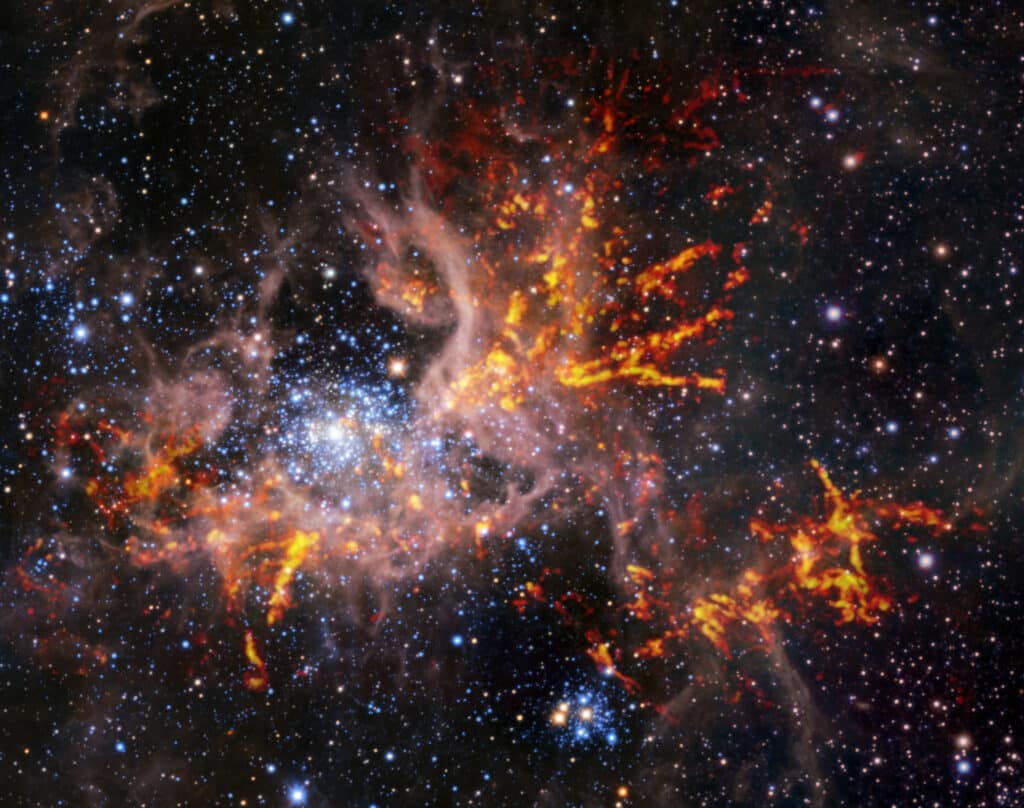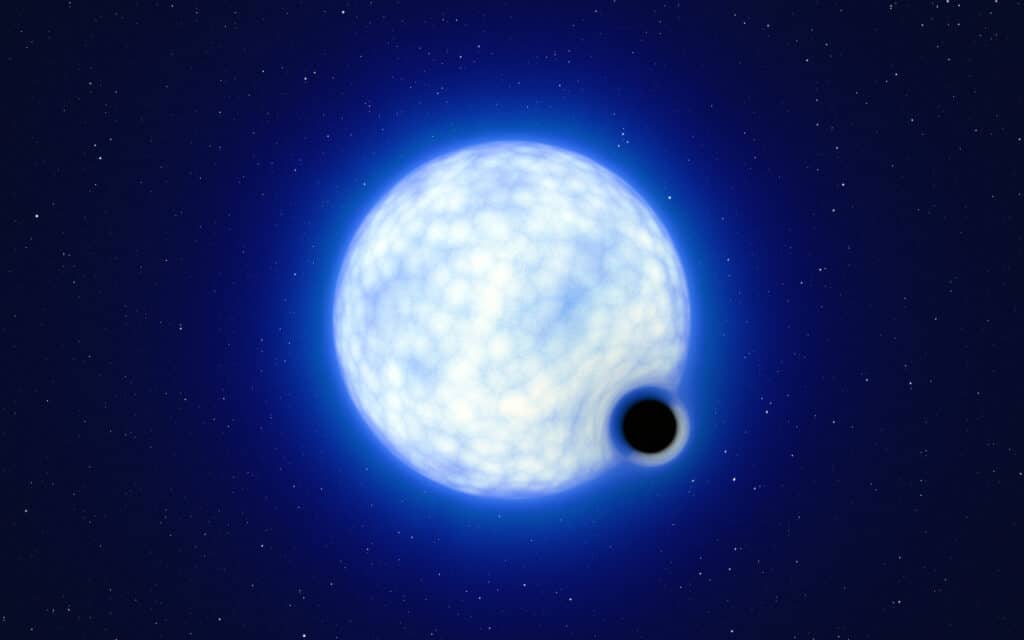A dormant black hole at least nine times the mass of the our Sun has been detected just 160,000 light years from Earth. It’s the first time one has been found “unambiguously” outside our galaxy. This sleeping giant is not currently devouring gas or other matter, astronomers say.
The dormant black hole lies in the Large Magellanic Cloud, a satellite galaxy that neighbors the Milky Way and orbits a hot, blue star that is almost three times as big.
Astronomers liken the discovery to finding a “needle in a haystack.”
“It’s incredible we hardly know of any dormant black holes given how common astronomers believe them to be,” explains study co-author Pablo Marchant of KU Leuven in Belgium, in a statement.
Dormant black holes are particularly hard to spot since they do not interact with their surroundings.
“For more than two years now we’ve been looking for such black-hole-binary systems. I was very excited when I heard about VFTS 243, which in my opinion is the most convincing candidate reported to date,” adds co-author Dr. Julia Bodensteiner, of the European Southern Observatory (ESO) in Germany.
The star that gave rise to it vanished without any sign of a powerful explosion.
The international team – dubbed the “black hole police” – searched nearly 1,000 massive stars throughout the spectacular Tarantula Nebula in the constellation of Dorado. Identifying companions as black holes is extremely difficult as so many alternative possibilities exist.

“As a researcher who has debunked potential black holes in recent years, I was extremely skeptical regarding this discovery,” says research leader Tomer Shenar who started the study at KU Leuven, and is now a Marie-Curie Fellow at Amsterdam University. “For the first time, our team got together to report on a black hole discovery – instead of rejecting one.”
Colleagues included Dr. Kareem El-Badry of Harvard University in Boston, who is nicknamed “black hole destroyer” by his peers. “When Tomer asked me to double-check his findings, I had my doubts. But I could not find a plausible explanation for the data that did not involve a black hole,” admits El-Badry.
The study also sheds light on how black holes are created from the cores of dying stars. It was uncertain whether or not this is accompanied by a powerful supernova explosion.
“The star that formed the black hole in VFTS 243 appears to have collapsed entirely – with no sign of a previous explosion,” explains Shenar. “Evidence for this ‘direct-collapse’ scenario has been emerging recently – but our study arguably provides one of the most direct indications. This has enormous implications for the origin of black-hole mergers in the cosmos.”

Stellar-mass black holes form when massive stars reach the end of their lives and collapse under their own gravity. In a binary system – two stars revolving around each other – this process leaves behind a black hole in orbit with a luminous companion. Black holes are “dormant” if they do not emit high levels of X-ray radiation, which is how they are typically detected. Identification of VFTS 243 was made thanks to six years of data obtained with ESO’s Very Large Telescope (VLT).
The FLAMES (Fibre Large Array Multi Element Spectrograph) scanner allows more than a hundred objects to be observed at once, a significant saving of time.
Despite the nickname “black hole police,” they actively encourages scrutiny. Thousands of stellar-mass black holes are believed to exist in the Milky Way and the Magellanic Clouds. They are much smaller than the supermassive black hole 27,000 light years from Earth that is powering the Milky Way.
“Of course I expect others in the field to pore over our analysis carefully, and to try to cook up alternative models. It’s a very exciting project to be involved in,” notes El-Badry.
The research is published in the journal Nature Astronomy.
Report by South West News Service writer Mark Waghorn















I would love to see some science around dormant black holes. These would be my questions I would like explored:
– If a dormant black hole *never* interacts with any matter ever again, will it eventually “die” (no longer be a black hole? Or will it be one forever and in a trillion years if something came close enough, devour that?
– If a black hole could eventually “die”, how long would it need to be dormant (no “food”) before it died?
– Are there any states between it is a black hole, and it is no longer a black hole? That would be interesting.
– If a black hole were to die, would we be able to see anything of the matter it had previously swallowed? Or would it have all been destroyed?
– What would a dead black hole look like in terms of matter? It seems like it swallowed/destroyed all matter while it was a black hole, would a dead black hole just no longer exist? Meaning nothing was there to observe?
– What would happen if two dead black holes collided?
Straight BS. You guys are friggin hilarious with your theories. Clueless that Satan invented astrology. I bet you still stand, put your hand on your heart and worship a flag! Wake up!!! You’re being deceived as it’s written.
After Satan invented astrology, he invented instant coffee.
Yes sir!
Wow…. Just wow. You crazy rednecks. Science and religion can coexist. Being ignorant is a choice. I suppose you believe that the Earth is still flat, the center of everything and was made only about 2,000 years ago. Screw the science, what you can see with your eyes or the fact that even religion has changed drastically over the last couple thousand years so that it fits the science of the time. Never mind that you probably have a microwave, satellite TV and a few other pretty cool gadgets… Like a cell phone all thanks to science. But when it doesn’t fit your ignorant religious doctrine, then you just throw it all out the window. You’re the most dangerous type of people in my book.
Moron alert
You think this article is about “astrology?” Talk about clueless!!!
Really need an emoji that reflects “dumb f*ck alert”. I’ll bet you voted for Trump and think voter fraud exists to the extent it could impact an election.
They don’t even know if it’s a black hole. If you read the statements under the images they say nothing about the black hole. If it’s a binary system you’d think that the black hole would be close enough to the star to remove material. It also says that what they say they found hasn’t been scrutinized by peers yet.
True. But the beauty of my questions is they are valid regardless of the status of this report. Black holes exist. Black holes go for periods of time not being “fed”. So, what happens to them if they never get fed again?
“dormant black hole” = Jussie Smollett